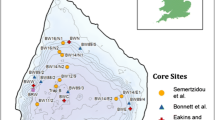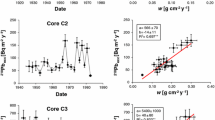Abstract
The fallout radionuclides 210Pb and 137Cs are widely used to date environmental records contained in lake sediments. Since the radionuclide records are themselves the outcome of the transformation of atmospheric fallout by mediating transport processes from the catchment, through the water column and post-depositional migration via pore waters, reliable models of these processes are crucial to accurate dating. The large quantities of data on 210Pb and 137Cs in lake sediments accumulated through their widespread dating applications may be used to study transport models. Their advantages as tracers of transport processes include widespread dispersal through the environment, relatively simple and well known input functions, and ease of measurement.
One of the principle factors controlling the transport of any species through the water column is its distribution between aqueous and particulate phases. The relatively solubility of 137Cs in the water column is demonstrated by the reduced 137Cs/210Pb inventory ratios in sediments compared to values expected from direct fallout. Using sediment records from a wide range of Cumbrian lakes, calculations based on simple models indicate that the particulate fraction of weapons fallout 137Cs in the water column ranged from 5-22%, and was proportional to the square root of the sedimentation rate (determined by 210Pb). The KD value for weapons 137Cs in the water column is estimated to be in the range 1-2×105 L kg-1. This is comparable with KD values for Chernobyl 137Cs in these lakes (Smith et al. in press) obtained from direct measurements in the water column.
Similar content being viewed by others
References
Appleby, P.G., Jones, V.J. & Ellis-Evans, J.C.: 1995, J. Paleolimnology, 13, 179–191.
Appleby, P.G. & Oldfield, F.: 1992. In: Uranium series disequilibrium (eds. M. Ivanovich & R.S. Harmon), OUP, pp. 731–778.
Appleby, P.G., Richardson, N., Nolan, P.J. & Oldfield, F.: 1990, Phil. Trans. R. Soc. Lond. B327, 233–238.
Appleby, P.G., Richardson, N. & Nolan, P.J.: 1991, Hydrobiologia, 214:35–42.
Appleby, P.G. & Smith, J.T.: 1993, Proc. UNESCO Workshop on the “Hydrological Impact of Nuclear Power Plant Systems”, UNESCO, Paris, pp.264–275.
Benoit, G. & Hemond, H.F.: 1987, Geochim. Cosmo. Acta, 51, 1445–1456.
Benoit, G. & Hemond, H.F.: 1990, Environ. Sci. Technol., 24, 1224–1234.
Bonnett, P.J.P. & Appleby, P.G.: 1994, Environmental Pollution, 83, 327–334.
Cawse, P.A. & Horrill, A.D.: 1986, A survey of 137Cs and Pu in British soils in 1977. AERE Harwell Report R-10155, HMSO, London, 55pp.
Cawse, P.A., Cambray, R.S., Baker, S.J. & Burton, P.J.: 1988, A survey of background levels of environmental activity in Wales, 1984–86 (Pre-Chernobyl), AERE Harwell Report R-12535, HMSO, 21pp.
Dominik, J., Burrus, D. & Vernet, J.-P.: 1987, Earth Plan. Sci. Lett., 84, 165–180.
Håkanson, L., Brittain, J.E., Monte, L., Heling, R., Bergström, U. & Suolanen, V.: 1996, J. Environ. Radioact., 33, 255–308.
Helton, J.C., Muller, A.B. & Bayer, A.: 1985, Health Physics, 48, 757–771.
Hilton, J, Livens, F.R., Spezzano, P. & Leonard, D.R.P.: 1993, Sci. Total Environ., 129, 253–226.
Imboden, D.M. & Schwarzenbach, R.P.: 1985, In: Chemical Processes in Lakes (ed. W. Stumm), Wiley Interscience, pp.1–30.
Lewis, D.M.: 1977, Geochim. Cosmo. Acta, 41, 1557–1564.
Pennington, W, Cambray, R.S. & Fisher, E.M.: 1973, Nature, 242, 324–326.
Pennington, W, Cambray, R.S., Eakins, J.D. & Harkness, D.D.: 1976, Freshwater Biology, 6, 317–331.
Santschi, P.H. & Honeyman, B.D.: 1989, Radiat. Phys. Chem. 34, 213–240
Scott, M.R., Rotter, R.J. & Salter, P.F.: 1985, Earth Plan. Sci. Lett., 75, 321–326.
Smith, J.T.: 1994, Mathematical modelling of 137Cs and 210Pb transport in lakes, their sediments and the surrounding catchment. PhD thesis, University of Liverpool.
Smith, J.T., Appleby, P.G. Hilton, J. & Richardson, N.: In press (a), J Environ. Radioact.
Smith, J.T., Leonard, D.R.P., Hilton, J. & Appleby, P.G.: In press (b), Health Physics.
Talbot, R.W. & Andren, A.W.: 1984, Geochim. Cosmo. Acta, 48, 2053–2063.
Wang, K. & Cornett, R.J., 1993.: J. Paleolimnology, 9, 179–188.
Author information
Authors and Affiliations
Rights and permissions
About this article
Cite this article
Appleby, P. Sediment Records of Fallout Radionuclides and their Application to Studies of Sediment-Water Interactions. Water, Air, & Soil Pollution 99, 573–586 (1997). https://doi.org/10.1023/A:1018368212808
Issue Date:
DOI: https://doi.org/10.1023/A:1018368212808




